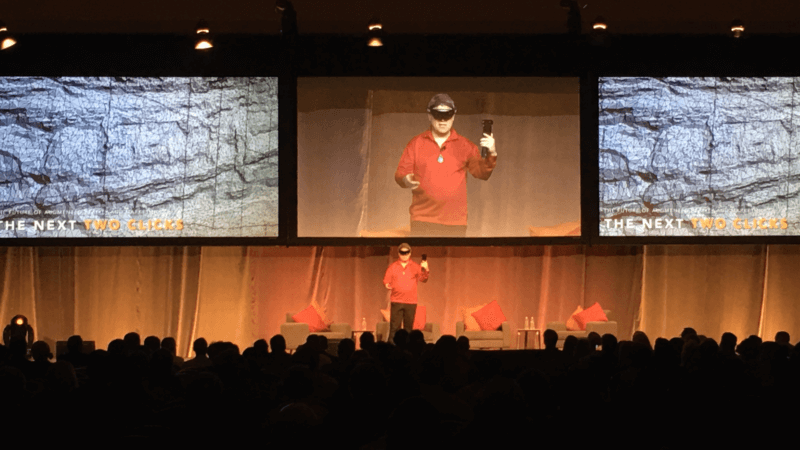It will have a profound effect, he says, on how products are designed, presented, sold and used.

Robert Scoble wearing glasses that are displaying 360-degree video from the camera he’s holding
Fasten your seatbelts.
Those weren’t the exact words used by tech evangelist and author Robert Scoble in a keynote address on Wednesday, the last day of our MarTech Conference in Boston. But that was the basic idea, as he touted the transformation that augmented and virtualized reality will have on marketing and advertising.
He predicted that, within three to five years, consumers, business buyers and marketers will commonly call up augmented reality (overlays on real scenes through smartphones and glasses) and immersive virtual environments (using goggles and glasses). The effect on marketing, he envisions, will be nothing less than profound.
For one thing, he said, AR and VR represent the fourth major wave of user interfaces. The first was command line, followed by graphical user interface and touch. And the fifth wave? Scoble envisions brain interfaces, already in development.
The purpose of the widespread use of AR and VR, he said, will be to apply “new meaning to the world,” redefining both the world and the products in it.
Of course, tech visionaries have been predicting artificial reality’s takeover since the term was born several decades ago. But the key pieces are now beginning to come together, including Apple’s ARKit and Google’s ARCore for smartphones, Facebook’s acquisition of Oculus, and the slow but steady building of infrastructure to support ads, marketing, products and experiences in those formats.
Scoble, who spends many of his days traveling to cutting-edge labs and startups, sees a critical mass of technology and applications converging on the horizon.
He pointed to a variety of projects among startups and established companies that are picking up the baton from Google Glass (now in its second act), hoping to find the right combo — perhaps lighter, or more colorful, or with a less visible camera — that works for users. Scoble pointed out that the right glasses could replace smartphones or, because they can show multiple “monitor screens” in the field of vision, possibly replace computer screens.
But he didn’t address how these glasses would overcome the factors that derailed Google’s headgear, notably the hostile reaction from other people who didn’t like the idea of being continually videoed by a Glass wearer. Lightweight glasses that present an entire world inside their view and don’t require a camera that continually watches everyone else are one thing. But augmented reality glasses overlay their additions on real-world images, requiring an outward-facing camera that could still face resistance.
Mapping and makeup
Smartphones’ screens, however, certainly work as AR portals. Scoble pointed to airports that are experimenting with colored follow-me lines and informational windows that overlay on real world scenes in a smartphone screen, guiding travelers to coffee, food or gates.
Labs for Westfield shopping centers are mapping every product in every store, he reported, so that overlays can guide shoppers to the exact purchase they want in a mall. PGA Tours is mapping its participating golf courses so virtual environments can be shown on smartphones and TV screens along with the live video of golf games. The National Football League is installing sensors in football gear, allowing fans to see informational popups about players on their devices or at home and allowing players to later learn from their own performance.
AR-enhanced makeup sessions in stores immediately show a variety of lipsticks or eye treatments on a live shot of a customer. Scoble expects that marketers, as a standard practice, will have to ensure that virtual versions of products exactly match their physical incarnations.
Physical products, of course, will also be sold through virtual displays, like the new 18-wheel truck that Scoble says he can visualize with a VR headset in his office. Or AR visualizations on smart phones will let customers see what’s inside a sealed product box, without opening.
Product design often occurs these days in 3D software, but the new tech will allow products to be designed and then visualized in fully realized AR and VR environments, and marketers may adapt versions of these walk-around visualizations for their campaigns. Per Scoble, Disney said its new park in Shanghai was designed using VR.
Data will commonly be viewed in AR or VR environments, so that marketers and other business users can walk around and physically manipulate the graphs, bar charts and other visualizations.
Musicians may commonly perform with a range of virtual electronic instruments played via headsets and tactile-feedback gloves, instead of setting up and breaking down physical ones. And the current trend toward virtual interfaces on screens, such as in car dashboards, will be boosted by holographic and augmented reality screens superimposed on physical devices.
“If you’re building a product with a physical interface,” Scoble said, “you should ask yourself why.”
Marketing Land – Internet Marketing News, Strategies & Tips
(66)
